With the ever-evolving technological landscape, it is not surprising to see that the newest technologies are often used to facilitate learning, especially to make it more authentic. For instance, several authors have reported how Augmented Reality (AR) (Cai et al., 2017; McCord et al., 2023; Sen et al., 2017) and Virtual Reality (VR) technologies (Neden, 2022; Theelen et al., 2022; Tepe et al., 2018) enhance authentic learning experiences and make such experiences more meaningful for learners, including in the context of training programs (Hwang et al., 2021). However, it is important to note that the mere presence of advanced XR technologies is unlikely to bring benefits; the purposeful design of courses, programs, or training to integrate such technologies matters. To this end, the purpose of this paper is threefold:
Authentic learning – This refers to a type of learning that is connected to the real world, mimics or models disciplinary practices, and is beneficial for someone’s future or current professional career and for their personal growth.
Immersive learning experiences – These entail educational settings that place learners in interactive scenarios that simulate real-life situations. In such educational settings, learners experience the feeling of being “present” in the simulated environment, thus making the learning experience more intense and realistic. This concept is closely related to the concept of physical realism.
Physical realism – This is the degree to which a computer-generated scene or object accurately mimics the real world, specifically in virtual environments. It includes the realistic representation of physical environments and the properties of materials within a simulated or virtual environment so that visuals and interactions are indistinguishable from those that would be perceived in the actual physical world.
Cognitive realism – We use this term in reference to the concept introduced by Herrington et al. (2003). This concept implies that, when designing for authentic learning, it is of greater importance to design complex, cognitively stimulating tasks and scenarios that allow learners to consider multiple perspectives and outcomes than to solely focus on replicating the physical realism of a given scenario, setting, or environment.
XR technology – This term refers to an umbrella concept that encompasses the use of Virtual Reality (VR), Augmented Reality (AR), 360° Videos (360° Vs), and Virtual Production Videos (VPVs).
Multiple scholars have discussed authentic learning as an effective pedagogical approach to learning in higher education and professional contexts in both face-to-face and online learning environments (Herrington & Herrington, 2007; Newman et al., 1996; Webster-Wright, 2009; Webster-Wright, 2010). The key argument that scholars who pioneered authentic learning put forth is that authentic learning allows learners to work in real-life situations and make their learning experiences relevant to their existing or future professional contexts. Apart from real-world relevance, authentic learning is a multifaceted concept and includes other dimensions (Abramenka & Ozogul, 2022; Shaffer & Resnik, 1999; Wald & Harland, 2017), such as the personal meaningfulness of learning experiences (Newman et al., 1996; Shaffer & Resnik, 1999; Wald & Harland, 2017). Per Shaffer and Resnick (1999), authentic learning has the following meanings: (1) learning that is personally meaningful, (2) learning that is connected to the outside world, (3) learning that mimics or models disciplinary practices, or (4) learning in which assessment is aligned with learning tasks. The above four meanings constitute thick authenticity. Therefore, authentic learning can be implemented using different pedagogical approaches depending on how authentic learning is conceptualized in a specific context. For example, the following approaches for authentic learning have been reported in higher education courses (Table 1).
Table 1
Pedagogical Approaches for Implementing Authentic Learning
Pedagogical Approach | Authors | Brief Description |
|---|---|---|
Project-based learning, including projects with a real client | Deale et al. (2010); Fitzsimmons (2006); Houke (2017); Lowell & Moore (2020); Parry & Reynoldson (2006); Peng et al. (2017) | This approach involves students working in real-life projects, including with a real organization, to help them with their task, problem, or project. |
Capstone projects | Collis et al. (2009) | In this pedagogical approach, students work on extensive and cross-disciplinary assignments. It frequently demands that students utilize the knowledge and competencies they have acquired over the course of their studies to tackle real-world problems. |
Studio pedagogy | Clinton & Rieber (2010) | The studio pedagogy approach offers teaching strategies that go beyond traditional lectures, seminars, or discussions. In this setting, the classroom transforms into a space for work and creation. |
Case-based learning | Ferry et al. (2006); Miner-Romanoff et al. (2017); Trespalacios, (2017); Vo et al. (2018) | Case-based learning (CBL) enables students to employ their understanding in practical, real-world situations, facilitating advanced cognitive skills (analysis, evaluation, and synthesis). |
Simulation-based learning | Koenders (2006); Ozverir et al. (2017) | In this approach, students solve complex tasks and problems in controlled/classroom environments through scenarios that mimic real-world situations. |
Field experiences | Schumacher & Reiners (2013) | These structured learning activities occur outside the classroom. These experiences aim to help students develop skills and competencies relevant to their major, equipping them for a variety of professional settings. |
The importance of authentic learning in higher education courses lies in providing students with disciplinary authenticity and real-world relevance. Various scholars (Houke, 2017; Lai et al., 2017; Luo et al., 2017; Ozverir et al., 2017; Peng et al., 2017; Trespalacios, 2017; Vo et al., 2018; Watson et al., 2017) have reported that authentic learning immerses students in tasks and activities similar to those that professionals encounter in real-world contexts. This immersion results in increased intellectual engagement and the development of knowledge and skills relevant across diverse professional contexts and settings.
As Table 1 shows, authentic learning has been used across different contexts and delivery modalities (face-to-face and online). When it comes to the online format, when students do not have the option to meet in a physical environment, the authenticity of tasks should take precedence over re-creating the physical environment of a specific professional setting. In this regard, Herrington et al. (2003) introduced the term cognitive realism, which describes how the authenticity and realism of learning tasks are more important than the physical reality of the learning situation. This concept was introduced more than 20 years ago when technology was not as advanced and sophisticated as it is now. Therefore, it is worthwhile to investigate and document how learning environments can combine cognitive realism with the physical realism of a specific situation.
The following section focuses on the integration of extended reality (XR) in educational environments and the benefits of XR technology in enhancing the authenticity of learning experiences. In addition to detailing the benefits of XR in making learning more authentic, this section also addresses the challenges associated with integrating XR into educational settings.
In this paper, we use the term Extended Reality (XR) in this paper as an umbrella concept that encompasses Virtual Reality (VR), Augmented Reality (AR), 360° Videos (360° Vs), and Virtual Production Videos (VPVs). Each has distinctive features and affordances both for design and learning (see Figure 1).
Figure 1 shows how XR manifests through four mediums with distinctive and overlapping ways of access from learners’ perspectives. Virtual production media manifests through videos that can be accessed only through a browser. 360° Videos manifest through 360° videos that can be accessed through a browser, a mobile app, or a headset. Virtual reality media manifests through videos/reality media that can be accessed only through a headset. Augmented reality media manifests through videos/reality media that can be accessed only through a mobile application.
Figure 1
Concept of Extended Reality[1]
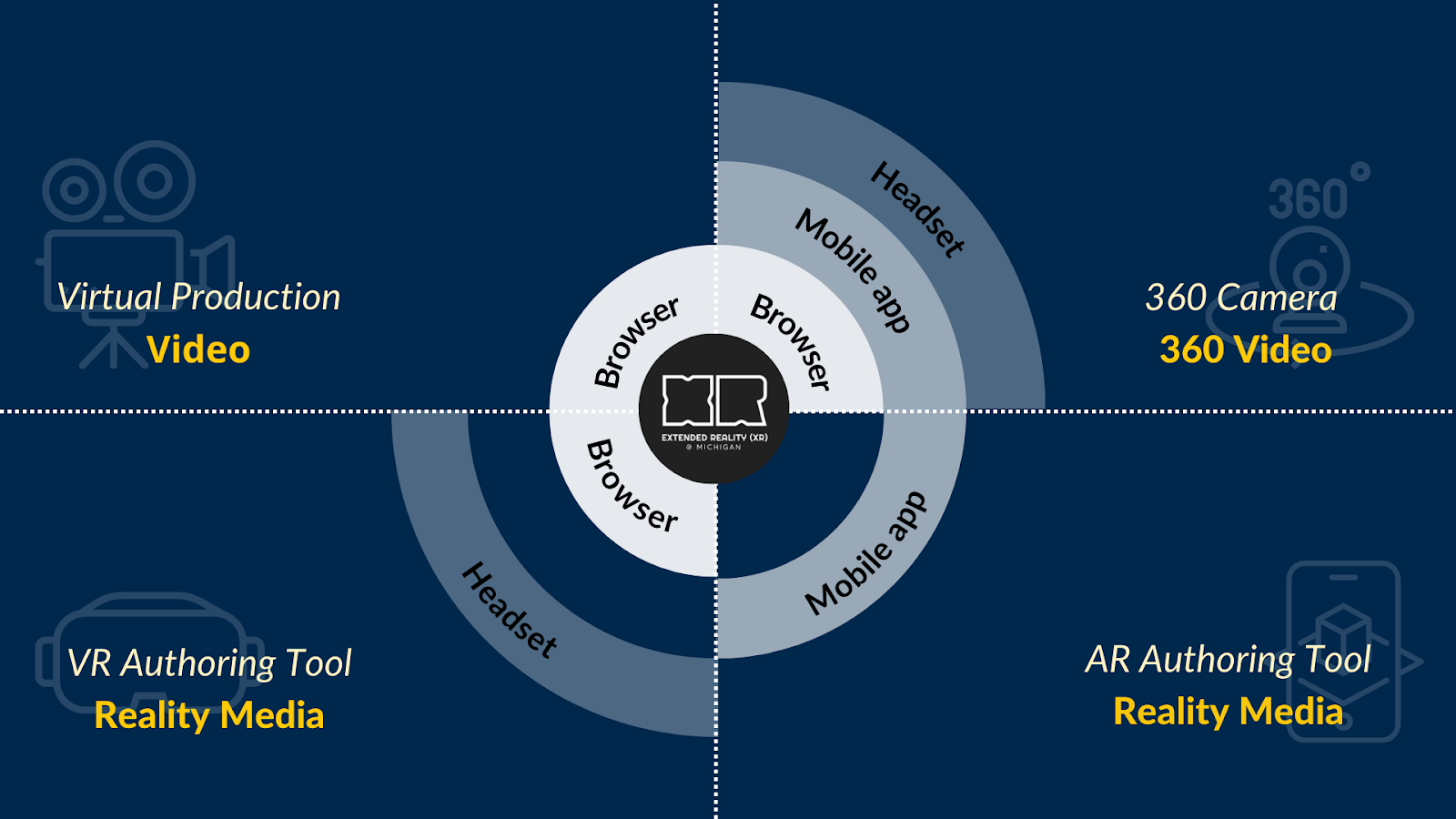
Incorporating XR into the curriculum of educational programs, including professional development programs, can undoubtedly enhance learning experiences and extend the boundaries of a physical classroom and even web-based technologies in online courses. That is, XR technology enables immersive learning experiences. The benefits of incorporating XR are well-documented in the literature, as different authors have reported the educational value of using XR across academic subjects and contexts (e.g., academic courses, open courses, and professional development). For instance, the integration of XR technologies provides opportunities for experiential learning to increase the effectiveness of learning and improve educational outcomes (Kim et al., 2023). Further, it can give students valuable opportunities to apply their knowledge in real-life scenarios. In other words, XR technologies can promote a learning-by-doing type of experience (de Giorgio et al., 2023; Kim et al., 2023; Obeidallah et al., 2023). For instance, Dieker et al. (2023) referred to a mixed reality simulator (i.e., TeachLivETM) that provides a safe space for educators to practice and improve their teaching skills. Further, Bishop (2016) discussed the use of e-mentoring adaptive systems with AR to provide context-specific interventions and just-in-time information. Additional research has documented how the integration of XR technologies fosters increased motivation to participate in learning and provides opportunities for self-directed, independent learning (Giesen et al., 2023; Xu et al., 2023; Zatarain‐Cabada et al., 2022). Some studies have suggested that XR technologies provide a higher sense of social presence (Chessa & Solari, 2021). In essence, XR technologies allow for the creation of immersive, hands-on, experiential, and situated learning experiences (de Giorgio et al., 2023; Kim et al., 2023; Obeidallah et al., 2023), which are the key characteristics of authentic learning. Providing students with enhanced experiences connected to the real world makes learning more relevant and meaningful.
Despite the above-listed benefits of integrating XR into the curriculum, there are several challenges associated with the use of XR technology. These challenges can be grouped into the following categories:
Cost: It is worth noting that advanced technologies such as extended reality (XR) require significant financial investment. Seyman-Güray and Kismet (2023), as well as Ellern and Cruz (2021), have pointed out that high costs are one of the principal barriers to adopting this technology. Similarly, Kluge et al. (2022) have highlighted the need for ongoing funding as a major obstacle to sustaining XR technology implementations.
Accessibility: Bailey and Won (2024) have specifically pointed out that current XR experiences often cater primarily to learners with full vision, hearing, and mobility, risking the exclusion of individuals with sensory or mobility impairments. The authors stress that although research has explored ways to make XR technology more accessible, implementing diverse nonverbal cues at a scale remains challenging. XR-enriched learning environments can also become less accessible due to physical discomfort, such as cyber-sickness. This condition mirrors motion sickness and can cause symptoms including blurry vision, nausea, vomiting, cold sweats, dizziness, and headaches (Obeidallah et al., 2023).
Technical Training and Support: It is worthwhile to point out that using XR technology effectively in the learning process requires technical training (de Giorgio et al., 2023). Other authors have also stressed the necessity of such training, as well as ongoing technical support, as significant challenges in the implementation of XR technology (Khlaif et al., 2024; Kluge et al., 2022). Kluge et al. (2022) further note that integrating XR technology into existing IT infrastructures poses specific difficulties, including limited customization options to meet particular learning needs.
Instructional design and pedagogical considerations: Obeidallah et al. (2023) emphasized that the lack of a clear framework for integrating XR technology into curricula—including course design —poses a significant challenge. Similarly, Meccawy (2022) highlighted the importance of aligning XR use with pedagogical goals to ensure that it enhances learning experiences, rather than serving merely as a tool without educational value. In this regard, Jiang et al. (2024) conducted a study to investigate the effectiveness of using 360° Videos and highlighted the importance of enhancing teaching strategies for learners in such learning environments. Their study has specifically highlighted the following aspects: 1) 360° Videos significantly impact non-cognitive outcomes like attitudes and motivation; (2) they are more suited for the acquisition of theoretical knowledge than practical skills, which need hands-on experience; (3) for authentic real-life scenarios, learners should be provided with interface scaffolding to foster self-directed learning; and (4) the individual use of 360° Videos may limit social interactions and, without effective teaching, could induce negative emotions, such as anxiety in pre-service teachers experiencing chaotic classroom scenes without guidance. Finally, learners’ individual characteristics are important; field-independent learners adapt more easily to 360° Videos, whereas field-dependent learners thrive in interactive settings.
Ethical Considerations: Privacy concerns arise when using XR technology due to the technology’s tracking and recording of users’ physical behaviors, which can communicate a wide array of information including attention and emotion (Bailey & Won, 2024). Meccawy (2022) has also noted that XR platforms collect enormous amounts of personal and behavioral data, which is the reason for privacy concerns.
Thus, when integrating XR technology, it is important to approach it from a well-balanced perspective, considering both the benefits and challenges of implementing such technology. It is worth noting that there is a reason why drawing on course design principles and theories matters when it comes to integrating XR technology; no single technology, even the most advanced and sophisticated, will yield benefits on its own. Therefore, in this paper, we present two concrete examples/vignettes of integrating XR technology with the use of design principles, specifically drawing on the theory of authentic learning, accessibility guidelines, and dimensions of Diversity, Equity, and Inclusion (DEI). The first vignette showcases how XR technology was integrated to increase the authenticity of learning experiences. The second vignette focuses on the limitations of existing technology for the purpose of professional development and discusses how integrating XR technology can compensate for these limitations and enhance authenticity.
The People, Technology, and the Future of Mobility course is a massive open online course (MOOC) that provides a layperson’s introduction to some of the major technological innovations currently underway in the mobility space. The learning experience in this course engages learners in applying various social science concepts to understand the likely social impacts of these technologies. This course challenges learners to envision a mobility of the future that is safer, cleaner, and more equitable. It examines recent technological advances, as well as the socio-economic and policy implications, of two major evolving mobility-related technology spaces: electrification and automation.
The course is suitable for learners from all backgrounds. It does not require prior engineering or social science training. Yet, the learning design targets the following two broad groups of learners:
The content of this course draws on several interviews and lectures from diverse academic and industry experts. Lectures prepared by industry experts, who provide real-life examples, bring disciplinary authenticity and relevance to the course—a characteristic of authentic learning. A multinational company that focuses on digitalization in the process and manufacturing industries, intelligent infrastructure for buildings, distributed energy systems, rail transport solutions, health technology, and digital healthcare services partnered to develop the course content, further bolstering its authenticity and relevance.
In this example, learners engage with 360° Video experiences either through a web browser or by using the Uptale application on their smartphones or a VR headset (see Figure 1). This variety of options allows learners to choose how to participate based on their individual affordances. The course includes three interactive 360° Video experiences that allow learners to (1) explore the key components of an autonomous vehicle, (2) go on a ride-along in an autonomous car, and (3) learn about the new sensing technology humans will see/experience in the smart cities of today and tomorrow. The major objective tied to the 360° video experiences is:
Experience a sense of immersion in an authentic research testing facility for mobility technology, while comprehending the different basic components of autonomous vehicles and their functions (in standby and in ride modes) and the different technologies that support autonomous vehicles in smart cities. (See Figures 2, 3 & 4).
The 360° Videos enhance the authenticity of the learning experience in the given example. It specifically fosters disciplinary authenticity and real-word relevance by providing learners with the sensation of sitting in and navigating a car. Since the course concentrates on the future of mobility, including the structure and function of electric cars, the incorporation of physical realism in the online setting is pivotal. It gives learners a sensation akin to actually being in the car and operating it. This enhancement of physical realism, facilitated by XR technology, enhances cognitive realism. This immersive car experience was designed to reinforce and deepen students’ understanding of electric car operations and to encourage students to engage with the topic at a deeper level and even find personal meaning in it apart from relevance to their current or future professions. The students could find personal meaning through this learning experience by exploring their personal preferences when it comes to transportation and by discovering new areas of interest, such as to what degree electric cars are sustainable, robust, and reliable. Thus, this example shows that XR technology can be invaluable in rendering learning experiences authentic.
Figure 2
The First 360° Video Experience in the Course: “Components of Autonomous Vehicles.” Through this experience, students learn about the exterior components of autonomous vehicles that are visible to the eye in a testing car while being immersed in a research testing facility for mobility technology.

Figure 3
The Second 360° Video Experience in the Course: “Experience a Ride Inside an Autonomous Vehicle.”
Participants learn through this experience about the interior components of autonomous vehicles that are visible to the eye in a testing car while riding in a car that drives autonomously.
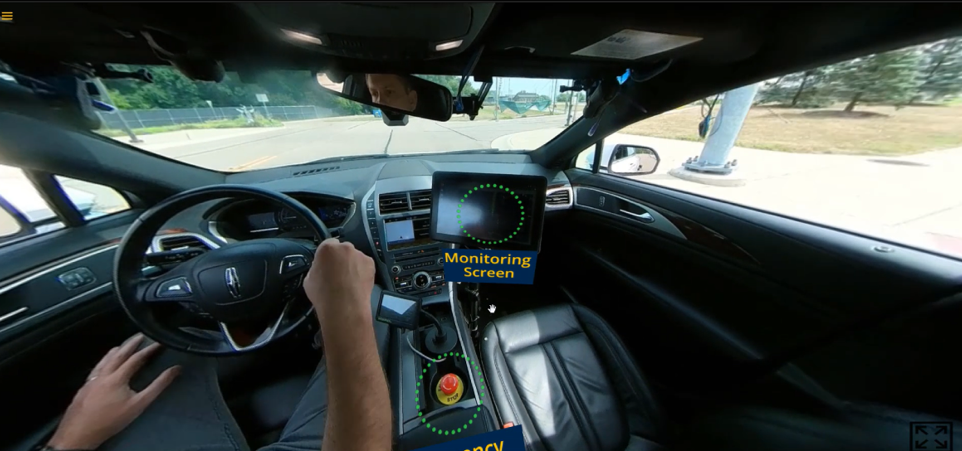
Figure 4
The Third 360° Video Experience in the Course: “Sensing Technologies in Smart Cities.” Students learn through this experience about the different, necessary technologies in future smart cities that make autonomous vehicles work while being immersed in a research testing facility for mobility technology.
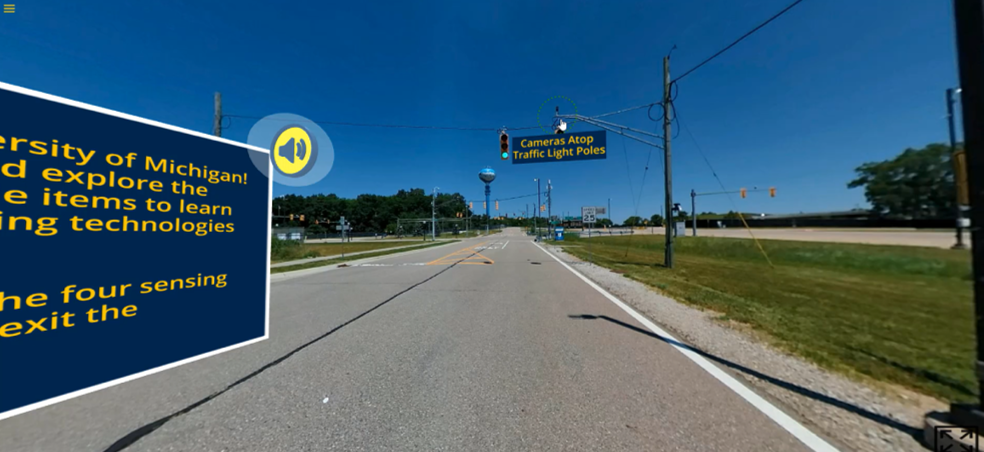
The goal of these three 360° Video experiences is to increase the authenticity of the overall learning experience of the course and immerse learners in an authentic environment—a nationally recognized research testing facility for mobility technology. In this example, both physical and cognitive realism (Herrington et al., 2003) played a significant role in creating the learning experience. Such experiences provide learners with a sense of immersion. This way, their learning experiences become more relevant to their existing or future professional contexts.
A major consideration in the creation of three 360° Video experiences was inclusive and accessible design (Lachheb et al. 2021 on Universal Design for Learning and its relation to inclusive design). This was accomplished by collaborating with learning designers who focus on accessibility (Saca, 2023). This consideration entailed mitigating and removing barriers for learners with or without disabilities. First, the design of three 360° video experiences ensures that learners can access these experiences using various devices and internet speeds: smartphones, desktop computers, and XR headsets. A single, specific device is not required. Secondly, the design of the audio/visual components of the 360° video experiences complies with the Web Content Accessibility Guidelines (WCAG) standards. This means that the text and audio are:
It is important to stress three important elements that were central to the design process and outcome. These elements are listed and described below.
The goal of including experts from the field in the course was to encourage learners to relate the theoretical content of the course with real-world practices. Thus, the key design intent was to help learners find meaning in the learning process so that they could resonate with this course on a professional and/or personal level. The creation of the three 360° Video experiences intended to immerse learners in a real-world experience and facilitate the meaning-making of their learning experiences.
Meaning-making from learning experiences is closely connected to the authenticity of learning experiences. The goal of the three 360° Video experiences is to bring learners to real-life situations in authentic environments without asking them to come to the physical campus. It is similar to how learners embark on a field trip with their classmates to learn and have fun at the same time. In fact, the other instructional/learning events in the course were heavily designed for the cognitive domain. Each event was meant to help learners reach a specific learning objective, ranging from remembering to analyzing levels of Bloom’s taxonomy. However, the 360° Video experiences were not designed for the cognitive domain only; they were designed for the affective domain as well (Martin & Reigeluth, 1999). Learners, through these three 360° Video experiences, can put on their XR headsets or cardboards and enjoy a virtual visit to a research/testing facility to learn about vehicle automation technology without being overwhelmed.
The dimensions of Diversity, Equity, and Inclusion (DEI) were a major focus in the design process of learning experiences. In this example, learners have options for which learning resources and activities to interact with, as well as how to access and interact with them. The learning experiences utilizing XR technology (such as 360° Videos) are optional to ensure equity in case the technology does not work for all learners. Instead, learners are given alternative learning resources (such as videos and accessible PDFs containing the script of the video). Those who can access the 360° Video experiences are presented with different options: (1) access through a browser or (2) access via the Uptale application with a headset. Despite the allure of state-of-the-art technology and the immersive experiences that technology can provide, it remains essential to consider learners’ unique needs, contexts, and circumstances to ensure the meaningfulness and authenticity of their learning experiences.
The Network for Educator Effectiveness (NEE) is a comprehensive educator assessment system designed by experts at the University of Missouri. Principals observe and evaluate teachers’ instructional practices, providing feedback for their professional growth. Classroom observation training is essential for effective instructional leadership, enabling valuable insights into teaching practices to improve student learning outcomes. (Akiri et al., 2021; Heck & Marcoulides, 1990; Wanzare, 2012).
NEE requires principals to attend yearly classroom observation training to refine their skills in observing teacher-student interactions using exemplar videos and rubrics. Since the COVID-19 pandemic, the training has been held via Zoom, where principals watch videos, agree upon a teacher indicator, score the interaction individually on a 7-point scale, and discuss their scores. The training allows educators to refine their instructional techniques for meaningful learning experiences, promoting understanding and knowledge transfer.
Classroom observation training with a Likert scale involves principals assessing teaching and learning by assigning ratings based on predefined criteria. Studies have discussed using Likert scales in educational research and evaluation, providing personalized feedback options for teachers’ individualized career development (Webster-Wright, 2009; Webster-Wright & Webster-Wright, 2010). Principals record ratings and provide context or examples to support their feedback, supporting teachers’ professional growth and development (Brookhart, 2010; Marzano et al., 2011).
Classroom observation training empowers principals to improve their teaching skills by identifying, evaluating, and enhancing authentic instructional practices. By observing, reflecting, and receiving feedback from principals, teachers can create more meaningful learning experiences that foster deep understanding in classrooms (Danielson, 2007; Guskey, 2002; Hammersley-Fletcher & Orsmond, 2004).
Although Zoom sessions for classroom observation training are not always feasible, the EdHub Library, an online professional development platform, hosts a collection of video examples of teacher-student interactions where principals can practice classroom observation skills through online self-paced activities (see Figure 5). The platform has over 500 asynchronous online professional development materials and around 38,000 users from three U.S. states (Kansas, Missouri, and Nebraska) and internationally. Teachers can search for materials using the homepage, search engine, and dedicated teacher indicator sitemaps.
Figure 5
The EdHub Library Homepage

The EdHub Library contains 84 interactive classroom observation simulations. These simulations use high-definition videos from annual in-person principal training sessions, recorded with permission from teachers, students, and school districts. The videos provide a close view of teacher-student interactions, filmed from the back of classrooms. They include all the necessary rubrics and components for practicing scoring, with built-in feedback mechanisms developed in Adobe Captivate. The master score is revealed at the end of each simulation.
The single-view classroom observation videos were designed using a message layering approach to modularize and distribute three interrelated layers (i.e., control, strategy, and content) that emulate the process of classroom observations (Gibbons & Boling, 2021). In the control layer, principals have separate screens for the critical activities of classroom observation in the following steps:
In the strategy layer, the left side holds teacher indicators and rubrics, while the right side holds multimedia with access to rubric information. Scoring is presented on the second screen. Each content layer contains logically distributed content across screens, allowing for focused attention on a task. Careful planning and preparation, including the necessary rubric material, are essential for classroom observations. The principal’s score from step 3 is not carried over to step 4 when comparing scores for fidelity and consistency. Without seeing scores, principals are encouraged to review the video example from the beginning. Consistent access to teacher indicator information and rubrics is ensured through all steps.
The interactive classroom observation training helps principals identify strengths and weaknesses in teaching practices by simulating a classroom observation. However, the videos available in the library offer only a single point of view, making it challenging to observe teacher-student interactions. Further, the lack of controls to zoom in on details in the video poses another challenge. To overcome this limitation, it is essential to incorporate 360° Video classroom observation videos that offer users a rich, immersive experience. This approach can lead to more authentic classroom observations by enhancing user engagement and offering improved control over video components outside the user’s immediate field of view. This project expands classroom observation videos to focus on diversity, equity, and inclusion (DEI) indicators in K-12 classrooms. The videos address:
The project includes feedback on three versions of the classroom observation training. In response to this feedback, four new teacher-student interactions will be recorded to demonstrate exemplary practices supporting DEI. The equipment will be upgraded to process 360° Videos editing with Adobe After Effects and Adobe Captivate, producing immersive experiences via desktop, mobile, and VR headsets (see Figure 1). Principals will be assigned to an immersive version to gather user experiences from an authentic learning perspective. Participants will allocate 45 minutes to complete four activities on desktop, mobile, or virtual reality headsets:
Figure 6 summarizes the sequence of activities using the three versions of classroom observation pieces of training.
Figure 6
A sequence of activities for data collection
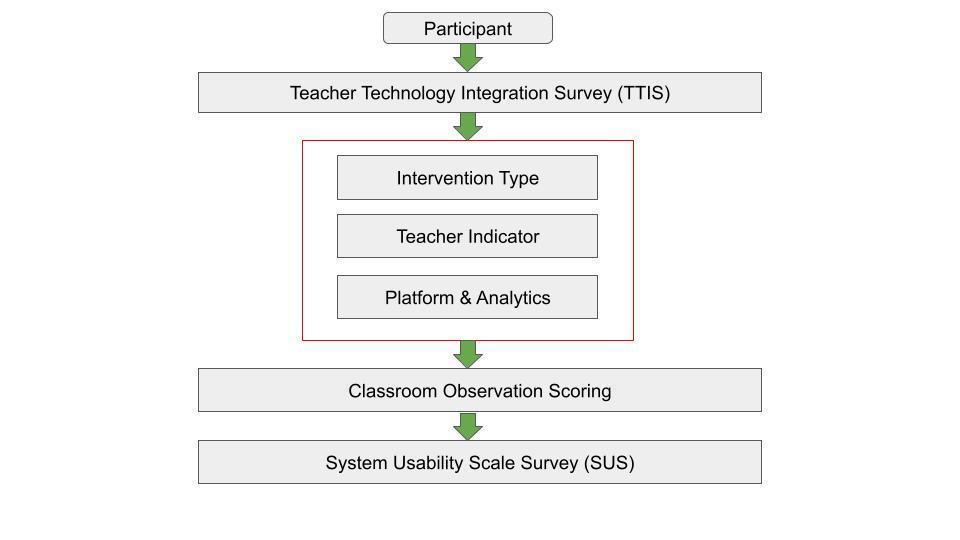
Principals can access 84 interactive training modules on single-view classroom observations. These modules cover multiple teacher indicators in the EdHub Library. The interactive training pieces are mobile-friendly and have been developed with Adobe Captivate. One example of a single-view classroom observation training is a training module for a teacher indicator on content knowledge academic language. To begin, the principal watches a classroom video with the rubric information for NEE 1.1 (Figure 7). After observing the video, the principal can practice scoring the teacher-student interaction video using a 7-point Likert scale while receiving feedback (Figure 8). Once the individual feedback is completed, the score justifications are provided at the end of the module using the teacher indicator information as a form of debriefing, similar to in-person training sessions before the pandemic (Figure 9).
Figure 7
Classroom Observation Video Example
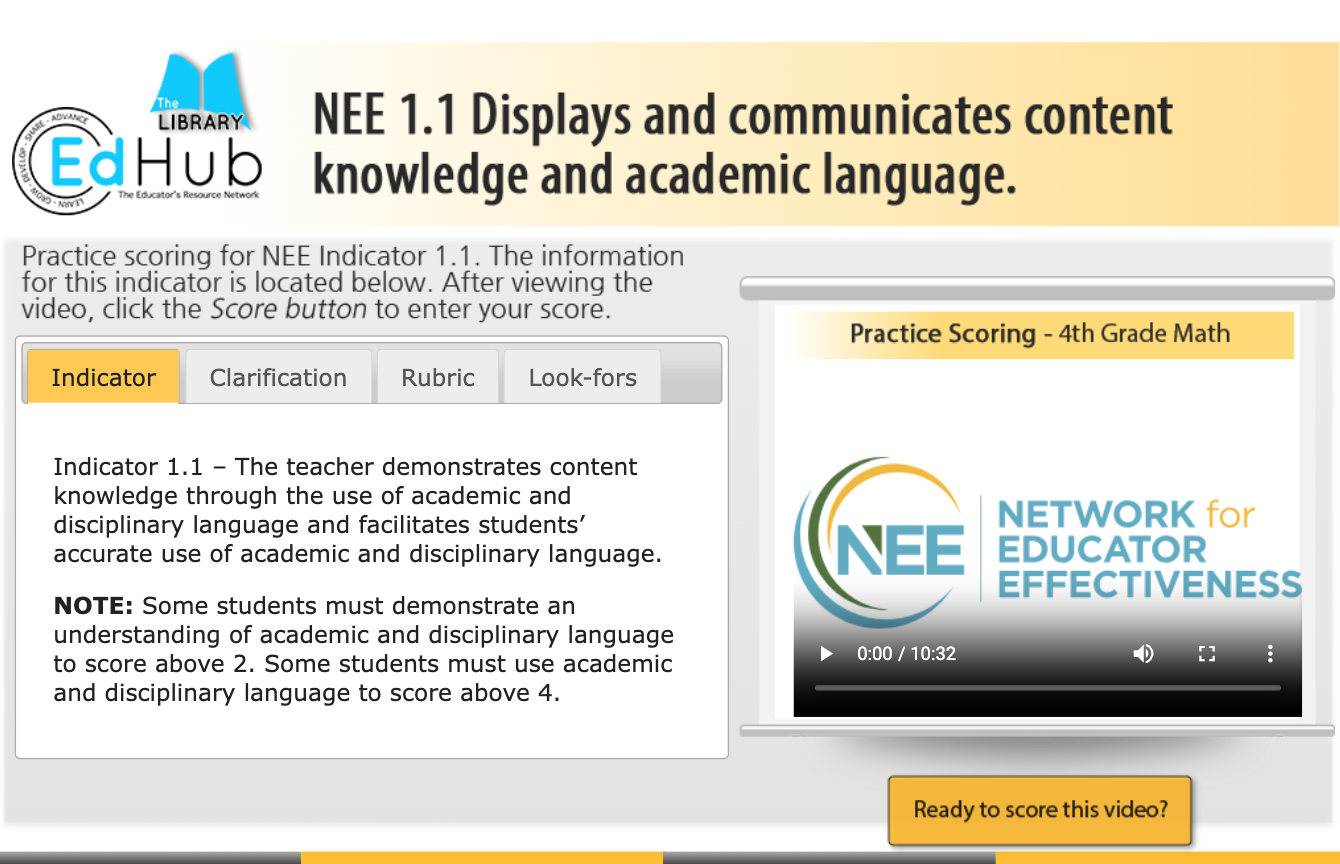
Figure 8
Classroom Observation Video Scoring
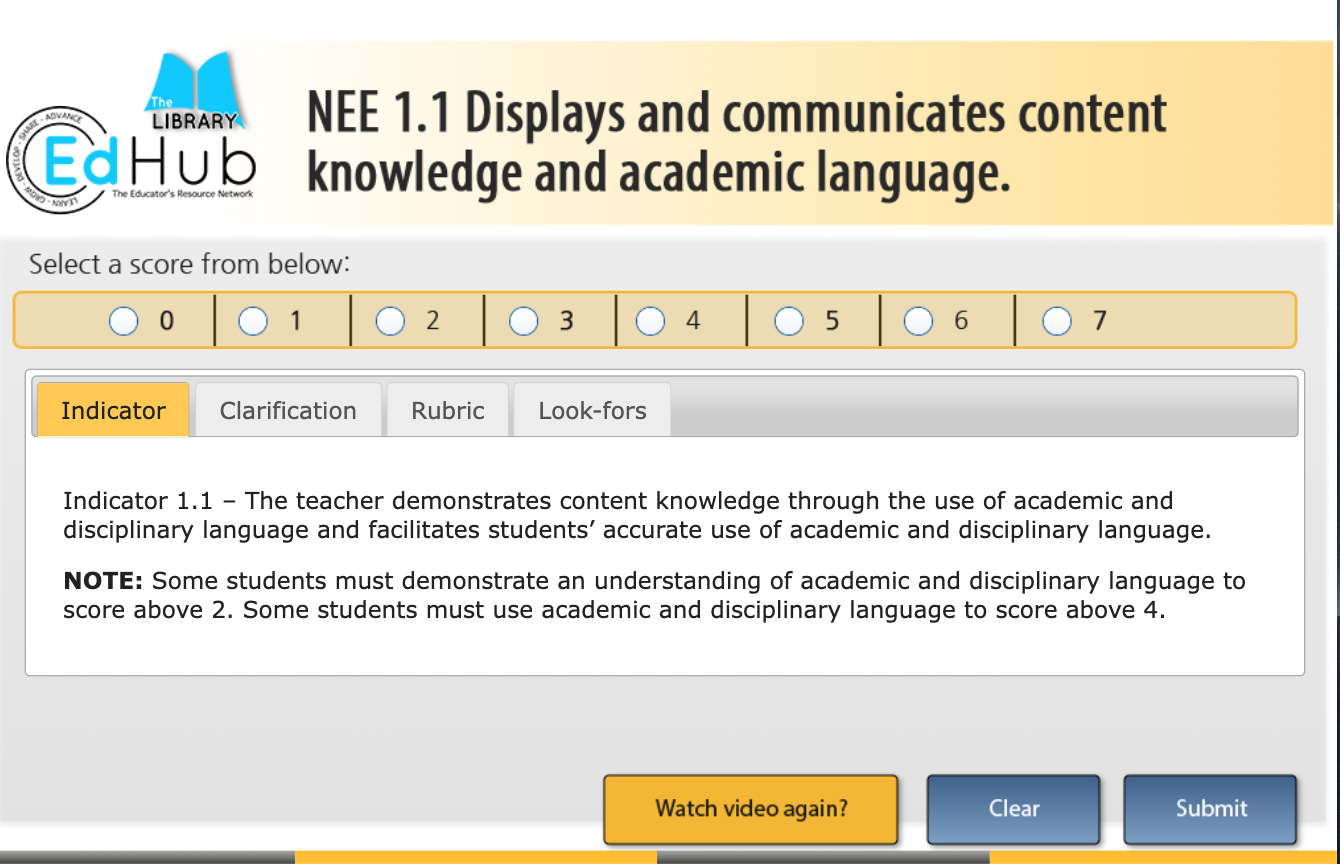
Figure 9
Classroom Observation Video Score Feedback
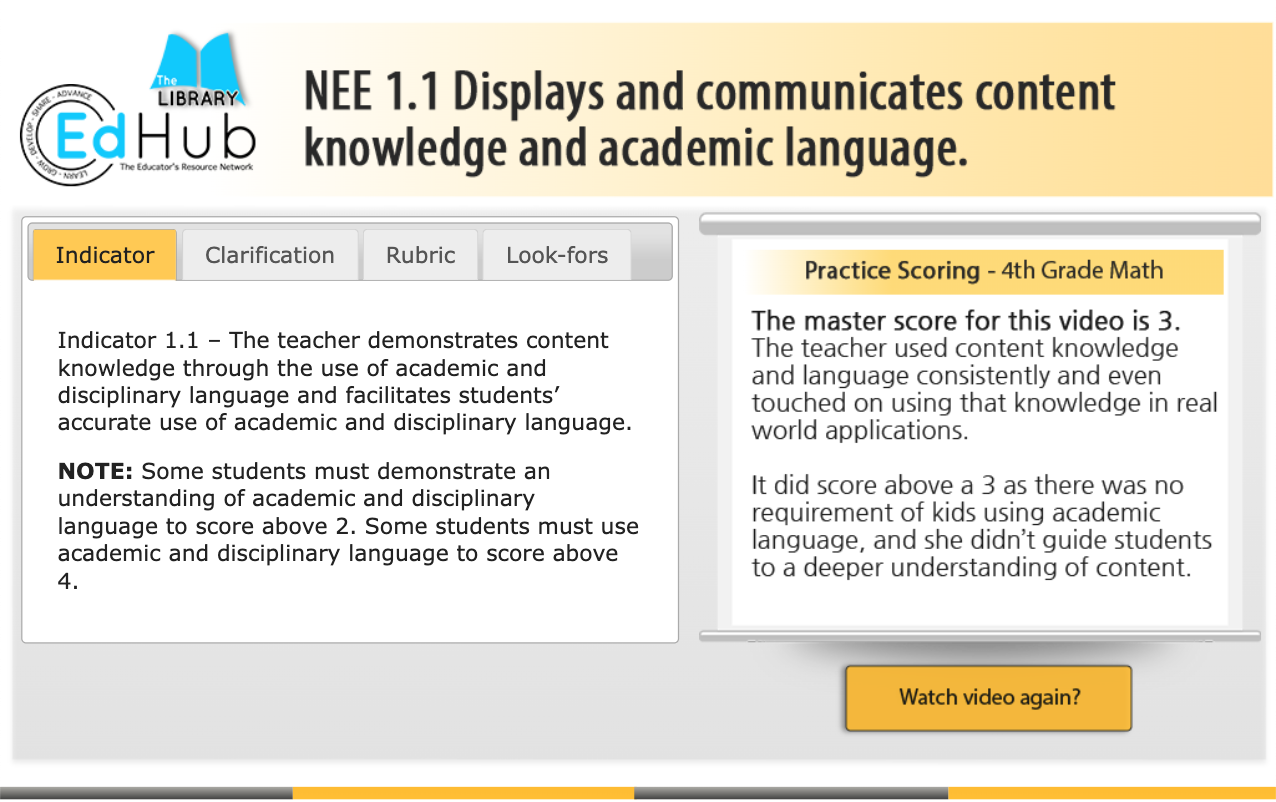
Four 360° Video immersive training videos will be created in addition to single viewpoint training videos. First, the recordings will be completed using the immersive camera equipment. Then, subject-matter experts will work with the instructional designer through a storyboarding process with Adobe Captivate, outlining four main steps. These steps will include a brief tutorial on immersive controls (and hardware for VR headsets), the teacher indicator information interface, the classroom observation scoring submission screen, and the master score justification. The TTIS and SUS surveys will be developed to be completed separately in Qualtrics. The immersive experiences of the four teacher indicators regarding DEI will be exported in the immersive versions (desktop, mobile, and VR headsets). The Adobe Learning Manager platform will serve as the primary deployment platform to track principals’ scoring and identify general usability issues.
The first type of classroom observation training, the single-view version, allows principals to emulate their administrative and evaluation routines in visiting classrooms to collect data for teachers’ professional development growth based on the observed teacher-student interactions and a teacher indicator. With asynchronous and self-paced training materials, principals can practice classroom observation skills on various teacher indicators, grade levels, and subjects throughout the school year. More importantly, principals can control the pace of their scoring practice and avoid the scoring fatigue experienced in face-to-face training sessions. Based on prior studies, principals’ access interactive training materials throughout the year and work individually or together in person or remotely through video conferencing to practice their scoring skills during the school year (Leung, 2018; Leung, 2022).
The immersive version of the second type of classroom observation training can increase principals’ experience in observing teacher-student interactions. As in the first example, a 360° Video environment enhances cognitive realism and fosters a sense of being “present.” In this example, such 360° Videos amplify the sensation of being “present” in the classroom, enabling principals to make more precise observations and provide more targeted feedback, allowing for more authentic professional development. This type of training ensures that principals have the knowledge and skills to provide meaningful feedback to teachers through evidence-based practices. Although there is a growing body of literature on the benefits of XR technologies in various fields, designing this experience and principals’ feedback allow program administrators to:
Overall, using immersive technology and XR training can increase authenticity in classroom observation training for principals. The immersive training approach offers a valuable tool for principals’ personal development growth by allowing principals to practice their classroom observation skills by visiting classrooms virtually. It also addresses the challenges of time constraints, scoring fatigue often experienced in traditional face-to-face training sessions, and the difficulty of limited manipulation in single-view online content. Since VR headsets may be cost-prohibitive in schools, it is anticipated that the desktop and mobile versions of the immersive training will be used more consistently due to ubiquitous technologies and the BYOD (bring your own device) option. Additionally, the data analytics of the immersive training versions can be analyzed to observe if principals exhibit self-regulated behaviors when seeking additional professional development materials.
The purpose of this paper is to document how the integration of XR technology occurs in practice with the purpose of making learning experiences more authentic and meaningful. Both vignettes feature a 360° Video environment, which creates immersive learning experiences and heightens the physical realism of a given setting. The immersive nature of such environments enhances the cognitive and physical realism of learning experiences, tapping into both the cognitive and affective domains. With these enhancements, learners have more opportunities to see the relevance of learning experiences to both their professional and personal lives and to find meaning in their learning.
When learning content and activities are complemented with learning experiences that allow for deeper engagement with topics or subject matter (such as classroom observations), learners or users (such as principals) gain access to more authentic experiences. Technology that enables the extension of the physical environment and enhances the realism of cognitive tasks by providing immersive, realistic experiences increases the authenticity of learning.
As multiple scholars have noted, integrating XR technology into a curriculum or classroom (face-to-face or online) provides opportunities for enhanced learning experiences through the immersive nature of such technologies (Giesen et al., 2023; Xu et al., 2023; Zatarain‐Cabada et al., 2022), which facilitate an experiential type of learning. These immersive experiences transcend passive learning by positioning learners within situated environments that mirror real-world scenarios, allowing learners to actively explore and make meaning of their learning. While XR technology’s benefits for authentic learning are evident, literature also indicates a set of challenges in its implementation, mainly related to its high cost (Ellern & Cruz, 2021; Kluge et al., 2022; Seyman-Güray & Kismet, 2023), accessibility (Bailey & Won, 2024; Obeidallah et al., 2023), and required technical training and support (de Giorgio et al., 2023; Khlaif et al., 2024). Ensuring XR experiences are accessible to all learners with different abilities requires addressing the diverse needs of learners. This lies at the heart of designing inclusive XR learning experiences that are accessible and engaging for learners of all abilities and backgrounds. The high cost of XR hardware and software can be a significant barrier to adoption and creates equity concerns. The literature also discusses possible solutions for developing low-cost XR, such as mobile platforms and cloud-based options (Alnagrat, et al., 2022; Cherner & Fegely, 2023).
The two cases described in this paper confirm key claims from the reviewed literature that XR enhances learning experiences and makes them more meaningful and authentic. The first case involved using XR in a MOOC course. Three interactive 360° video experiences enhanced the learning process by engaging students in authentic environments. The major consideration in the inclusive and accessible design of the three 360° video experiences was mitigating accessibility barriers for all learners. The second case included the use of XR for a training program for K12 principals through both single-view and immersive versions of classroom observation. The application of instructional design (ID) principles and DEI increased the authenticity of principals’ experiences in observing teacher-student interactions, allowing them to provide meaningful feedback to teachers based on evidence-based practices.
While the overall purpose of integrating XR technology in both vignettes/examples appears to be consistent—increasing the authenticity of the learning experience—it is important to consider that these vignettes depict different contexts, highlighting that design is both contextual and situational (Boling & Gray, 2014). Obeidallah et al. (2023) noted that the lack of a framework for course design with XR is a challenge for utilizing XR. While an established set of principles and guidelines, like accessibility principles, is helpful, it would be hard to imagine a universal set of guidelines and principles related to course design and the use of XR, as each design situation is unique. Studies like the one conducted by Jiang et al. (2024) have expanded our understanding of the range of experiences XR technology can offer learners and how individuals with varying characteristics and abilities may differently engage with XR-enriched learning environments. Given that learning design situations may differ and are context-dependent, studies like this help explore the multifaceted impacts of XR integration on cognitive, affective, and psychomotor domains.
Additionally, when integrating XR technology to enhance the authenticity of learning experiences, it is important to acknowledge that the concept of authentic learning has multiple definitions and interpretations. Therefore, the mere provision of immersive experiences by XR does not automatically guarantee the authenticity of learning. It is important to consider a variety of characteristics of authentic learning, such as personal meaningfulness and relevance. Given that personal meaningfulness can vary from person to person, in practice, it may seem infeasible to consider while designing. At the same time, the movement around DEI, which designers use as a design tool or design lens (Abramenka-Lachheb & de Sequeira, 2022; Lachheb & Quintana, 2021) to create inclusive learning experiences, can be regarded as an attempt to create learning experiences that are not only professionally relevant but also personally meaningful.
There is an ongoing debate over the importance of cognitive realism versus visual or physical representations of real-life situations. It appears that, with ever-advancing technology and the demands of today’s job market, learning experiences should be even more relevant and authentic. That is, both cognitive and physical realism matter. They complement each other and, together, constitute the organic whole. For instance, the physical realism of a given situation or scenario in XR should not be overwhelming to the extent that it takes away from the problem or learning opportunity it represents. Thus, we argue that, while striving for authenticity with advanced technology, it is important to strike a balance between the cognitive and physical realism of a given scenario or a problem.
In sum, through these two vignettes, we aim to highlight key considerations for designing XR environments and experiences that foster authentic learning. Therefore, we believe it is important to take the following steps:
In conclusion, this paper aimed to present both theoretical and practical views on designing authentic learning experiences with the use of immersive technology, such as XR. With the help of including the design vignettes, we aimed to accomplish the following goals:
Our manuscript offers a critical review of XR technology as well as a practical perspective on its real-world application. Instructional/learning design practitioners, as well as educators, can leverage this study to explore ways to integrate XR technologies into their specific contexts. Additionally, this paper can serve as a means to critically evaluate such technologies and to reflect on one’s professional practices. By providing detailed accounts of the vignettes mentioned, our goal is to enable other instructional/learning designers and educators to learn vicariously.
This paper stressed the importance of considering learners’ perspectives on the use of XR technology. Therefore, future research can specifically focus on learners’ perspectives while considering their diverse backgrounds and characteristics. In addition, future research could specifically focus on identifying what makes learners’ experiences worthwhile in XR-enriched environments. Future studies could also investigate what elements contribute to worthwhile experiences in XR environments. For instance, while textual annotations have been shown to aid information retention (Albus & Seufert, 2021), they do not necessarily enhance comprehension or deeper learning. Therefore, it is worthwhile to investigate how the use of XR technology influences learners’ ability to enhance their understanding, reasoning, and generally promote higher-order thinking skills. Additionally, future research should explore whether XR technology truly offers equitable learning opportunities without widening the divide among learners and what measures can be taken to reduce such disparities.
While the research has shown the benefits of using such technology for authentic learning, including its application in education and program development for immersive and engaging experiences, it is always worth considering the limitations of such technology and the nuanced and complex nature of different design situations. Moving forward, the trajectory of research and development in XR holds promise in addressing those limitations and the multifaceted nature of diverse design situations.
To foster learning environments that are not only professionally relevant but also personally meaningful to learners, ongoing efforts to innovate the XR learning experience to increase authenticity will play a pivotal role. Educators can also develop a nuanced understanding of how XR can be optimally integrated into various learning contexts by identifying technological affordances and use cases. Through two vignettes, we highlighted the potential of XR technology to create authentic learning experiences, focusing on its relevance in education and program development while acknowledging the importance of considering its limitations and the need for ongoing innovation to maximize its impact.
[1] Concept for the Extended Reality (XR) Illustration by Dr. Rebecca M. Quintata (with contributions from others) is copyrighted by The Center for Academic Innovation XR Initiative, The University of Michigan. Used with permission from The Center for Academic Innovation XR Initiative and Dr. Rebecca M. Quintata on 12/5/2023. CC BY License of the article does NOT apply to this illustration.